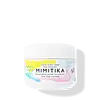What's inside
What's inside
 Key Ingredients
Key Ingredients

 Benefits
Benefits

 Concerns
Concerns

 Ingredients Side-by-side
Ingredients Side-by-side

Water
Skin ConditioningIsoamyl Laurate
EmollientAlcohol Denat.
AntimicrobialPolyester-8
Skin ConditioningBis-Ethylhexyloxyphenol Methoxyphenyl Triazine
Skin ConditioningPhenylbenzimidazole Sulfonic Acid
UV AbsorberButyl Methoxydibenzoylmethane
UV AbsorberPhenyl Trimethicone
Skin ConditioningCaprylyl Methicone
Skin ConditioningPropanediol
SolventAluminum Starch Octenylsuccinate
AbsorbentEthylhexyl Triazone
UV AbsorberSodium Hydroxide
BufferingAcrylates/C12-22 Alkyl Methacrylate Copolymer
PEG-40 Hydrogenated Castor Oil
EmulsifyingHydroxyacetophenone
AntioxidantAcrylates Copolymer
Phenoxyethanol
PreservativeNiacinamide
SmoothingDisodium Lauriminodipropionate Tocopheryl Phosphates
CleansingHydrolyzed Adansonia Digitata Seed Extract
Hydrolyzed Soy Protein
HumectantRice Amino Acids
Skin ConditioningProline
Skin ConditioningArginine
MaskingCoco-Glucoside
CleansingDisodium Lauryl Sulfosuccinate
CleansingAscorbyl Glucoside
AntioxidantHydroxystearic Acid
CleansingWater, Isoamyl Laurate, Alcohol Denat., Polyester-8, Bis-Ethylhexyloxyphenol Methoxyphenyl Triazine, Phenylbenzimidazole Sulfonic Acid, Butyl Methoxydibenzoylmethane, Phenyl Trimethicone, Caprylyl Methicone, Propanediol, Aluminum Starch Octenylsuccinate, Ethylhexyl Triazone, Sodium Hydroxide, Acrylates/C12-22 Alkyl Methacrylate Copolymer, PEG-40 Hydrogenated Castor Oil, Hydroxyacetophenone, Acrylates Copolymer, Phenoxyethanol, Niacinamide, Disodium Lauriminodipropionate Tocopheryl Phosphates, Hydrolyzed Adansonia Digitata Seed Extract, Hydrolyzed Soy Protein, Rice Amino Acids, Proline, Arginine, Coco-Glucoside, Disodium Lauryl Sulfosuccinate, Ascorbyl Glucoside, Hydroxystearic Acid
Water
Skin ConditioningCyclopentasiloxane
EmollientEthylhexyl Methoxycinnamate
UV AbsorberDimethicone
EmollientParfum
MaskingEthylhexyl Triazone
UV AbsorberButyl Methoxydibenzoylmethane
UV AbsorberGlycerin
HumectantEthylhexyl Stearate
EmollientBehenyl Alcohol
EmollientUndaria Pinnatifida Extract
Skin ConditioningHydrolyzed Algin
Magnesium Sulfate
Manganese Sulfate
Skin ConditioningHelianthus Annuus Seed Oil
EmollientSodium Stearoyl Glutamate
CleansingSilica
AbrasiveGlyceryl Stearate
EmollientSodium Polyacrylate
AbsorbentSodium Acrylate/Sodium Acryloyldimethyl Taurate Copolymer
Emulsion StabilisingIsohexadecane
EmollientPolysorbate 80
EmulsifyingSorbitan Oleate
EmulsifyingBHT
AntioxidantDehydroacetic Acid
PreservativeBenzyl Alcohol
PerfumingTocopherol
AntioxidantBeta-Sitosterol
Emulsion StabilisingSqualene
EmollientWater, Cyclopentasiloxane, Ethylhexyl Methoxycinnamate, Dimethicone, Parfum, Ethylhexyl Triazone, Butyl Methoxydibenzoylmethane, Glycerin, Ethylhexyl Stearate, Behenyl Alcohol, Undaria Pinnatifida Extract, Hydrolyzed Algin, Magnesium Sulfate, Manganese Sulfate, Helianthus Annuus Seed Oil, Sodium Stearoyl Glutamate, Silica, Glyceryl Stearate, Sodium Polyacrylate, Sodium Acrylate/Sodium Acryloyldimethyl Taurate Copolymer, Isohexadecane, Polysorbate 80, Sorbitan Oleate, BHT, Dehydroacetic Acid, Benzyl Alcohol, Tocopherol, Beta-Sitosterol, Squalene
 Reviews
Reviews

Ingredients Explained
These ingredients are found in both products.
Ingredients higher up in an ingredient list are typically present in a larger amount.
Also known as Avobenzone, this ingredient is a chemical sunscreen filter that provides protection in the UV-A range.
Avobenzone is globally approved and is the most commonly used UV-A filter in the world.
Studies have found that avobenzone becomes ineffective when exposed to UV light (it is not photostable; meaning that it breaks down in sunlight). Because of this, formulations that include avobenzone will usually contain stabilizers such as octocrylene.
However, some modern formulations (looking at you, EU!) are able to stabilize avobenzone by coating the molecules.
Avobenzone does not protect against the UV-B range, so it's important to check that the sunscreen you're using contains other UV filters that do!
The highest concentration of avobenzone permitted is 3% in the US, and 5% in the EU.
Learn more about Butyl MethoxydibenzoylmethaneEthylhexyl Triazone is a modern chemical sunscreen that protects from UV-B radiation.
It is the most effective of existing UV-B filters, as it provides the highest level of photo-stable absorption. It protects from the entire UV-B range (280 to 320nm), with it's highest level of protection at 314nm.
Ethylhexyl Triazone is oil soluble, oderless and colorless, which mean it is able to be incorporated into a variety of different formulations.
It is not currently available within the United States due to slow changing FDA regulations. Outside of the US, it is used in formulations at concentrations up to 5%.
Learn more about Ethylhexyl TriazoneWater. It's the most common cosmetic ingredient of all. You'll usually see it at the top of ingredient lists, meaning that it makes up the largest part of the product.
So why is it so popular? Water most often acts as a solvent - this means that it helps dissolve other ingredients into the formulation.
You'll also recognize water as that liquid we all need to stay alive. If you see this, drink a glass of water. Stay hydrated!
Learn more about Water